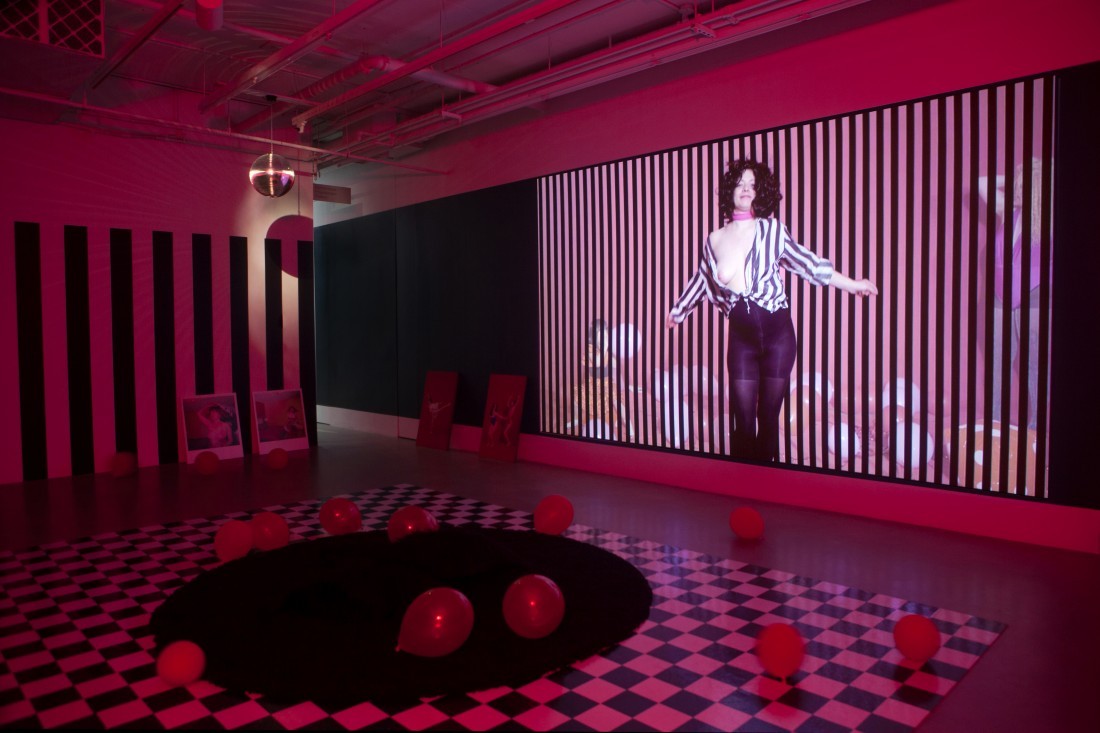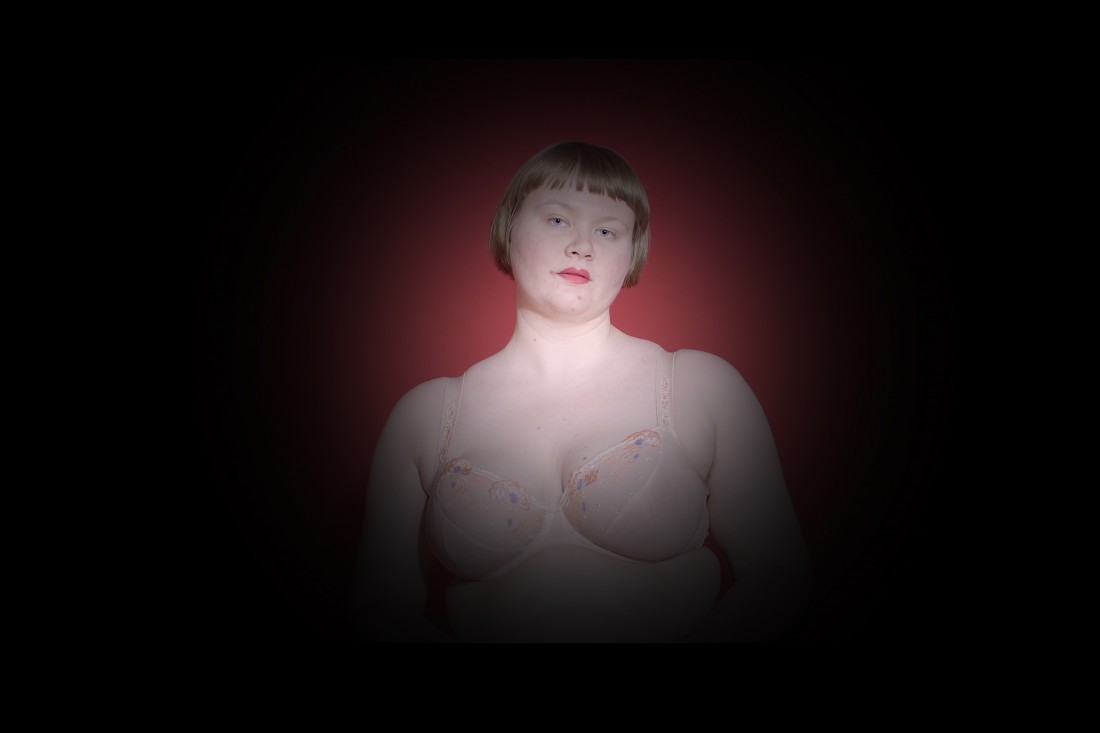Karen Asher
Winnipeg artist Karen Asher has so far been known primarily for her impressive photography. Her intimate portraits, which could call to mind Nan Goldin and Diane Arbus, are often set in unstaged domestic environments or unidentifiable outdoor locations and focus on everyday people. Still, they display an astonishing ability to reveal the extraordinary in the ordinary. Faces, expressions and bodies, as well as the shabby furniture and various other traces of daily life surrounding them, all are enveloped in an atmosphere of intense symbolism, which carries distinctly dark undertones. Asher called her last photographic exhibition “The Full Catastrophe,” and, indeed, some lurking sense of danger could be felt within and behind every suspended moment.
In her new solo exhibition at Plug In ICA, more subtly titled “Class,” Asher, for the first time, makes video, which forms part of a larger installation, the focus of her work. This transition from photography to video, which perhaps seems a logical creative evolution for a visual artist, pushes her work in an entirely new and liberating direction. The artist openly speaks about how, despite being attracted to video for a while, she had reservations based on her inexperience with the medium. Such fears, however, rapidly dissipated during the early stages of this first experiment: “As soon as I looked at the camera’s screen and started filming, I thought: What have I been doing all these years? I’m obsessed with video. You can see so much more.” In other words, capturing “the full catastrophe,” the full extent of action happening on set freely and dangerously, felt natural for Asher, perhaps unsurprisingly given that her main artistic objective had always been to resist staging and create an immersive flow from which she could previously only steal a series of singular moments.

Karen Asher, installation view, “Class: Karen Asher,” 2019, Plug In ICA, Winnipeg, MB. All photos: Karen Asher. Images courtesy Plug In ICA, Winnipeg.
Unlike most of her photographs, the video shown in “Class” was recorded in a studio-like setting, allowing Asher more control over aesthetic parameters such as wardrobe and props. Recruiting a group of her female, trans and non-binary friends, she strove to create a relaxed and safe space for playful self-expression, a little pocket of suspended judgment, where everyone could let their guard down, where anything could happen. Asher simply made notes on the emotions that she wanted to capture, rather than deciding on any specific content in advance. In the end, the video’s impactful soundtrack and extensive whimsical editing (both done in collaboration with her significant other, web designer Kevin Doole), and the motion inherent to the medium, allowed Asher to overcome the heavy darkness lurking in her still images.
At 82 minutes long, the video is comprised of situations that a couple of hundred years ago (but hey, maybe even today) might easily evoke witchcraft— a politically charged term that is historically operative in relation to (especially female) intuition, expression, knowledge and sexuality. Unconventionally attired performers, now in wigs, now in masks, other times in vintage underwear, surrounded and covered by cheap, exuberant props, perform eccentric, almost ritualistic movements and dances by themselves or with each other, doing so not for our gaze, and especially not for the normativizing male gaze, but out of their own integrity and joy. This is where the effects of Asher’s media shift become highly apparent. Whereas the photographic camera invites voyeuristic, detached scrutiny by arresting and isolating singular moments, video, and specifically Asher’s video, uncompromisingly integrates viewers into the unfolding situation, making us self-conscious about such containment. Not stripping down to your pink underwear and joining the performers on the screen in their free and unabated rituals might just leave you feeling a little bit like a freak.

Installation view, “Class: Karen Asher,” 2019, Plug In ICA, Winnipeg, MB.
Asher also creates this feeling of immersion by spilling the atmosphere of the studio space out into the gallery. The white cube was transformed into some kind of fantasy zone, painted in a checkered pattern, equipped with comfortable sofas, beanbags, fuzzy carpet and pillows, and filled with coloured balloons that seemed to have been thrown through the screen by the performers. A few of Asher’s old and new photos were stacked, overlapping, against the wall, the new ones parodying racy ’70s and ’80s car-shop posters, featuring lean female dancers flattened onto an erotically red background. A neon sign reading “Class(y)” (the “y” flashing) and a Harvey Edwards poster with the words “Dance Is Work” added a hidden, politically relevant dimension to what seemed overall to be a pretty fun and feel-good show. “We’re here, we die. It’s all funny,” remarked Asher in her artist talk at Plug In. Certainly, her work creates such an impression. It’s all funny. And it’s all horrible. At one point during the talk, Asher pulled out a little pair of children’s panties, prettily printed with circus animals, and explained how she safe-kept them in a drawer as a child, because they were the most beautiful thing she owned. Tragically, little Asher outgrew her panties before she’d ever decided to put them on. The story evoked some of the insecurities Asher grew up with, having been born into a working-class family and harbouring artistic inclinations. While developing an amiable, streetsmart personality, she satisfied her artistic cravings first as a dancer, later as a photographer. When Asher encountered the slogan “Dance Is Work,” she was exhilarated and in disbelief: How can something that feels so joyful and natural to her be work? It is a dilemma she seems to be still grappling with, and one that is surely familiar to many artists. Is art work? And how is Asher’s installation a commentary on this impossible question?
I would suggest that in an increasingly biopolitically regulated, economically strained and environmentally doomed world, creating pockets of uncompromised free expression, as Asher managed to do in “Class,” is without doubt seriously hard work. Especially relevant in our age of surveillance culture, dominated by formulas for exhibiting our identities and our bodies, the creation of spaces for spontaneity is not only laborious and courageous but also provides an important message to anyone grappling with an overwhelming socio-political context: find a way to wear those panties, baby. You deserve it. ❚
“Class: Karen Asher” was exhibited at Plug In ICA, Winnipeg, from April 27 to June 30, 2019.
Monika Vrec˘ar is a media theorist living in Winnipeg.

